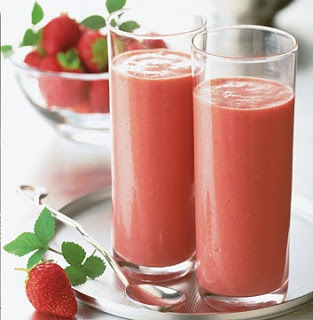If you are not already a fan of strawberries, you should become. Not only are they juicy, summery and delicious, they are also in all respects a remarkable food. Full of nutrients and antioxidants (such as vitamin C), strawberry offers a wide range of health benefits, some of which may surprise you. (Protection against wrinkles Yes, of course!) Here are 10 reasons to put more strawberries to your menu.
They increase immunity
"Strawberries are an excellent source of vitamin C," says dietician allowed Madeleine Edwards, based in Toronto. Most mammals, except humans, have the ability to naturally produce vitamin C, which is why it is so important for us to take daily. "One serving of strawberries contains 51.5 mg of vitamin C, about half of your daily needs, says Madeleine Edwards. Double portion and a cup of strawberries, you fill all of your needs. "We know that vitamin C boosts immunity while being a powerful antioxidant that works fast. A study from UCLA (University of California at Los Angeles) conducted in 2010 revealed that the antioxidant power of the cutter becomes "bioavailable" or ready to act in the blood after they ate only a few weeks.
They promote healthy eyes
The antioxidant properties of strawberries can also help prevent the formation of cataracts, progressive clouding of the lens of the eye, which can lead to blindness in old age. Our eyes require vitamin C to protect against exposure to free radicals from the sun's UV rays that can damage the lens proteins. It also plays an important role in strengthening the cornea and the retina of the eye. Although high doses of vitamin C can increase the risk of cataracts in women over 65 years, researchers at the Karolinska Institutet in Stockholm note that this risk is due to the vitamin C obtained from supplements, and not provided with fruits and vegetables.
They help fight cancer
Vitamin C is an antioxidant that can help prevent cancer because the immune system, when healthy, is the best defense of the organism. A phytochemical component, ellagic acid, also present in strawberries-is another. "We found that ellagic acid has cancer and notably that of slowing the growth of cancer cells properties, says Madeleine Edwards. Strawberries contain other antioxidants such as lutein and zeaxanthin. Antioxidants are free radical scavengers which neutralize the potentially negative effects that these can have on our cells' effects, she adds. The term "free radical" refers to damaged cells that can weaken the cells around them trying to repair themselves, an activity that can lead to cellular abnormalities and even cancer.
They have wrinkle effects
Vitamin C contained strawberries is essential for the formation of collagen, supports the elasticity and resilience of skin substance. As aging is losing collagen, eat foods that contain vitamin C can we maintain a healthier skin and more youthful. But vitamin C is not the only natural wrinkle present in strawberries. Researchers at Hallym University in South Korea, found that ellagic acid prevented collagen destruction and inflammatory effect, two major factors in the development of wrinkles following sustained to UV-B exposure harmful dermally.
They fight against the bad cholesterol
According to the Foundation of heart disease, heart disease is a leading cause of death among Canadian women. However, strawberries contain a powerful stimulant of heart health. "Ellagic acid and flavonoids, phytochemicals, or elements have beneficial for heart health antioxidant, explains Madeleine Edwards. For example, they can neutralize the effects of low-density lipoprotein or LDL, the bad cholesterol blood that allows platelets to accumulate in the arteries. Another advantage is that they have an anti-inflammatory effect which is good for the heart. "
They reduce inflammation of the joints
Antioxidants and phytochemicals present in strawberries can help reduce joint inflammation, a possible source of arthritis and heart disease. A study by the Harvard School of Public Health found that women who eat 16 strawberries a week or more were 14 percent. 100 less likely to have high levels of C-reactive protein (CRP)-index of the presence of inflammation in the body.
They regulate blood pressure
Potassium is another nutrient that promotes heart health with a concentration of 134 mg per serving, strawberries are considered "average source" of potassium according to the Health Services of Alberta. Potassium can help regulate blood pressure and may even help lower blood pressure by acting as a buffer against the negative effects of sodium. Since their effect on reducing LDL, inflammation and hypertension, strawberries have a reputation of being one of the most heart-healthy fruits you can eat.
They are a source of fiber
The fibers are necessary for proper digestion and strawberries contain about 2 grams per serving. Among the problems resulting from a lack of fiber, there is constipation and diverticulitis, or inflammatory bowel disease, which affects about 50 percent. 100 people over 60 years. The fibers can also help fight type 2 diabetes. "Fiber helps slow the absorption of sugars (such as glucose) in the blood, says Madeleine Edwards. That's why adults with diabetes can eat strawberries-in moderation. "
They help maintain a healthy weight
Maintaining a healthy weight is one of the best defenses against type 2 diabetes and heart disease, not to mention well-being. "In the strawberries, there are few calories (about 28 per serving), no lipid and low in sodium and sugar, says Madeleine Edwards. They contain natural sugars, but their total sugar content is low enough, or 4 g per serving, and total carbohydrate content is less than what is found in a half-slice of bread. Triple your portion to 1.5 cup: you'll get a taste of less than 100 calories, and much better for health than prepackaged snacks to 100 calories! "













.jpg)